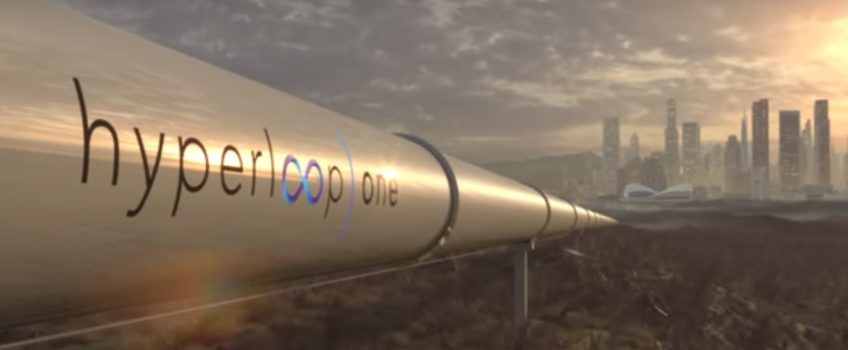
The recent successful test of the Hyperloop One is proof that the future of transport is at our fingertips. The near-supersonic transit concept used magnetic levitation for the first time on the ‘DevLoop’ test track in a vacuum environment. Co-founder Shervin Pishevar claims that by achieving full vacuum, they’ve essentially created a sky in a tube as if traveling 200 000 feet in the air.
The latest test showed speeds of 308 km/h (192 mph) on the 500-meter (1,640-foot) test track in Nevada where all system components functioned as intended. The next phase is to reach speeds of 400 km/h (250 mph) with an even bigger picture in mind – connecting cities.
The Hyperloop In a Nutshell
Elon Musk open-sourced the technology a few years ago and Hyperloop One is just one of a few companies in the race for commercialisation. The Hyperloop is working and not just a concept; it’s the first new mode of transport in over 100 years. Take a look at what the system entails:
- The pod is the aerodynamic vehicle to transport people, parcels or larger cargo. The design will greatly depend on the intended purpose.
- The pod is propelled by a linear electric motor similar to a circular electric motor but with the static electromagnetic part of the circle unfolded linearly along the track.
- The tube is depressurized to a partial vacuum which reduces the resistance between pod and air. Magnets used to levitate the pod further reduce friction and together with the low-pressure allows the pod to glide along without the effect of turbulence.
- The system is mostly automated where software sends pods down the tube in close proximity. Traffic and destinations will dictate where the pods join and will divert as required.
Combine all these components and the result is rather impressive – a ground transport mode theoretically capable of traveling at over 960 km/h (600 mph). According to claims, Hyperloop could be operational in just a few years using land previously allocated to the HS2. It remains to be seen exactly when and how the network of tubes will be developed but it’s a reminder of how far we’ve come. It gives us a similar feel of excitement like being so close to hypersonic travel.
Hyperloop Network Infrastructure
Cities will be able to link up and people living hundreds of miles away will be able to take advantage of the many opportunities in the big city. More and better job opportunities will be easier accessible than ever before.
Talks are underway to install the system in Europe and the U.S. with feasibility studies in other areas as well. Some of these include the UK, Finland, Moscow, Sweden, Switzerland, the Netherlands and UAE. Connections in the U.S. could include San Francisco and Los Angeles, Portland and Seattle, or New York and Washington. In the UK, London to Liverpool, Newcastle, Leeds or Manchester can take 30 minutes or less.
Taking it a step further, London can connect with Wales, Scotland and other areas with greatly reduced travel times. Other possible global connections include Abu Dhabi to Al Ain with Slovakia to be the central hub between Vienna, Bratislava and Budapest.
Hyperloop One believes their system will be more than just a people carrier. The plan is to have pods that carry people and small packages but also specially designed pods for cargo as big as a shipping container.
Imagine a time where we can move away from our ports and avoid costly storage close to city centers. There is so much more we can do like connect factories and supply chains directly to the distributors.
What About The Challenges?
Despite the successes and promises, there are still some challenges to overcome. First and foremost, it needs the right allowances, land acquisitions and regulatory approvals similar to the railway industry. Other potential obstacles include the following:
- Maintaining the low pressure over hundreds of miles will be a daunting task.
- Seismic activity or subsidence could push the tube out of alignment creating a dangerous situation.
- How will it be protected against attacks in more volatile regions?
- What about evacuation plans and protocols in case of emergency?
- The astronomical cost involved to build and maintain what is essentially, a brand new and mammoth infrastructure.
All these challenges affect the prospect of success but cost in particular is a concern. Perhaps not so much going from design to prototype but prototype to production is a different story. Where will the funding come from and how much is needed to effectively maintain the system?
With more impressive Hyperloop tests reaching higher speeds, the technology is showing what it’s truly capable of. The goal is to complete three production hyperloops by 2021 and is a mere glimpse of what the future holds for our transport system.
Please post a comment below or contact us via the website to share your thoughts on the future of transport with Hyperloop technology.
Our expertise covers a range of industries including rail, automotive, aerospace, defense and construction. You can also find us on Twitter, Facebook, You Tube, Google + or LinkedIn.
This site uses Akismet to reduce spam. Learn how your comment data is processed.


 Mail:
Mail: 




Leave a Comments